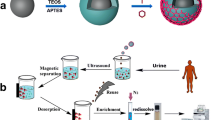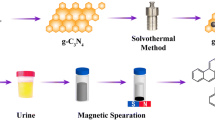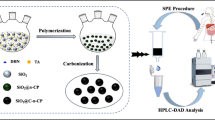Abstract
A novel magnetic organic porous polymer (denoted as Fe3O4@PC-POP) was developed for magnetic solid-phase extraction (MSPE) of two gastric cancer biomarkers (P-cresol and 4-hydroxybenzoic acid) from urine samples prior to high-performance liquid chromatographic analysis. The adsorbent was characterized by scanning electron microscope, transmission electron microscope, FTIR, powder X-ray diffraction, and other techniques. The result of dynamic light scattering shows that the particle size of the adsorbent is mainly distributed around 400 nm. Based on the design concept of the Fe3O4@PC-POP, the proposed material can effectively capture the target analytes through electrostatic and hydrophobic interaction mechanism. Furthermore, the enrichment conditions were optimized by the response surface method, and the method was utilized for the determination of P-cresol and 4-hydroxybenzoic acid in real urine samples from health and gastric cancer patients with high enrichment factors (34.8 times for P-cresol and 38.7 times for 4-hydroxybenzoic acid), low limit of detection (0.9–5.0 μg L−1), wide linear ranges (3.0–1000 μg L−1), satisfactory relative standard deviation (2.5%–8.5%), and apparent recoveries (85.3–112% for healthy people’s and 86.0–112% for gastric cancer patients’ urine samples). This study provides a guided principle for design of the versatile polymer with specific capturing of the target compounds from complex biological samples.

Graphical abstract





Similar content being viewed by others
References
Wittekmd C, Compton CC, Greene FL et al (2002) TNM residual tumorclassification revisited. Cancer 94:2511–2516
Ychou M, Boige V, Pignon JP, Conroy T, Bouché O, Lebreton G, Ducourtieux M, Bedenne L, Fabre JM, Saint-Aubert B, Genève J, Lasser P, Rougier P (2011) Perioperative chemotherapy compared with surgery alone for resectable gastroesophageal adenocarcinoma: an FNCLCC and FFCD multicenter phase III trial. J Clin Oncol 29:1715–1721
Jayanthi VSPKS, Das AB, Saxena U (2017) Recent advances in biosensor development for the detection of cancer biomarkers. Biosens Bioelectron 91:15–23
Siegel RL, Miller KD, Jemal A (2015) Cancer statistics, 2015. CA Cancer J Clin 65:5–29
Abbas M, Habib M, Naveed M, Karthik K, Dhama K, Shi M, Dingding C (2017) The relevance of gastric cancer biomarkers in prognosis and pre- and post-chemotherapy in clinical practice. Biomed Pharmacother 95:1082–1090
Dunn WB, Broadhurst DI, Atherton HJ, Goodacre R, Griffin JL (2011) ChemInform abstract: systems level studies of mammalian metabolomes: the roles of mass spectrometry and nuclear magnetic resonance spectroscopy. Chem Soc Rev 40:387–426
Chen JL, Fan J, Lu XJ (2014) CE-MS based on moving reaction boundary method for urinary metabolomic analysis of gastric cancer patients. Electrophoresis 35:1032–1039
Liang Q, Wang C, Li B (2015) Metabolomic analysis using liquid chromatography/mass spectrometry for gastric cancer. Appl Biochem Biotechnol 176:2170–2184
Chen Y, Zhang J, Guo L, Liu L, Wen J, Xu L, Yan M, Li Z, Zhang X, Nan P, Jiang J, Ji J, Zhang J, Cai W, Zhuang H, Wang Y, Zhu Z, Yu Y (2016) A characteristic biosignature for discrimination of gastric cancer from healthy population by high throughput GC-MS analysis. Oncotarget 7:87496–87510
Pijls KE, Smolinska A, Jonkers DM et al (2016) A profile of volatile organic compounds in exhaled air as a potential non-invasive biomarker for liver cirrhosis. Sci Rep 6:19903
Luo P, Yin PY, Hua R et al (2018) A large-scale, multicenter serum metabolite biomarker identification study for the early detection of hepatocellular carcinoma. Hepatology 67:662–675
Wang J, Zhang T, Shen X, Liu J, Zhao D, Sun Y, Wang L, Liu Y, Gong X, Liu Y, Zhu ZJ, Xue F (2016) Serum metabolomics for early diagnosis of esophageal squamous cell carcinoma by UHPLC-QTOF/MS. Metabolomics 12:116
Lu YH, Li N, Gao L et al (2016) Acetylcarnitine is a candidate diagnostic and prognostic biomarker of hepatocellular carcinoma. Cancer Res 76:2912–2920
Tian Y, Liu X, Duan J et al (2018) Prediction of chemotherapeutic efficacy in non-small cell lung cancer by serum metabolomic profiling. Clin Cancer Re 24:2100–2109
Kashani FZ, Ghoreishi SM, Khoobi A, Enhessari M (2019) A carbon paste electrode modified with a nickel titanate nanoceramic for simultaneous voltammetric determination of ortho- and para-hydroxybenzoic acids. Microchim Acta 186:12
Belenguer-Sapia C, Pellicer-Castell E, Vila C et al (2019) A poly (glycidyl-co-ethylene dimethacrylate) nanohybrid modified with β-cyclodextrin as a sorbent for solid-phase extraction of phenolic compounds. Microchim Acta 186:1–11
Shi Y, Zhang JY, He J et al (2019) A method of detecting two tumor markers (p-hydroxybenzoic acid and p-cresol) in human urine using a porous magnetic <beta >−cyclodextrine polymer as solid phase extractant, an alternative for early gastric cancer diagnosis. Talanta 191:133–140
Wu D, Xu F, Sun B, Fu R, He H, Matyjaszewski K (2012) Design and preparation of porous polymers. Chem Rev 112:3959–4015
Jiang JX, Cooper A (2010) Microporous organic polymers: design, synthesis, and function. Topics Curr Chem 293:1–33
Budd PM, Butler A, Selbie J, Mahmood K, McKeown NB, Ghanem B, Msayib K, Book D, Walton A (2007) The potential of organic polymer-based hydrogen storage materials. Phys Chem Chem Phys 9:1802–1808
Li Z, Yang YW (2017) Creation and bioapplications of porous organic polymer materials. J Mater Chem B 5:9278–9290
Zhang W, Aguila B, Ma S (2017) Potential applications of functional porous organic polymer materials. J Mater Chem A 5:8795–8824
He J, Xu FJ, Chen Z et al (2017) AuNPs/POPs as a new type of SERS substrate for sensitive recognition of polyaromatic hydrocarbons. Chem Commun 53:11044–11047
Qian L, Jian BS, Jian TS et al (2011) Graphene and graphene oxide sheets supported on silica as versatile and high-performance adsorbents for solid-phase extraction. Angew Chem 50:5913–5917
Jiang B, Wu Q, Deng N, Chen Y, Zhang L, Liang Z, Zhang Y (2016) Hydrophilic GO/Fe3O4/Au/PEG nanocomposites for highly selective enrichment of glycopeptides. Nanoscale 8:4894–4897
Zhang C, Li G, Zhang Z (2015) A hydrazone covalent organic polymer based micro-solid phase extraction for online analysis of trace Sudan dyes in food samples. J Chromatogr A 1419:1–9
Wei W, Lu R, Xie H, Zhang Y, Bai X, Gu L, da R, Liu X (2015) Selective adsorption and separation of dyes from an aqueous solution on organic–inorganic hybrid cyclomatrix polyphosphazene submicro-spheres. J Mater Chem A 3:4314–4322
He G, Peng H, Liu T, Yang M, Zhang Y, Fang Y (2009) A novel picric acid film sensor via combination of the surface enrichment effect of chitosan films and the aggregation-induced emission effect of siloles. J Mater Chem 19:7347–7353
Hu X, Long Y, Fan M et al (2018) Two-dimensional covalent organic frameworks as self -template derived nitrogen-doped carbon nanosheets for eco-friendly metal-free catalysis. Appl Catal B Environ 244:25–35
Ma HC, Kan JL, Chen GJ, Chen CX, Dong YB (2017) Pd NPs-loaded homochiral covalent organic framework for heterogeneous asymmetric catalysis. Chem Mater 29:6518–6524
Wang H, Wang C, Yang Y, Zhao M, Wang Y (2017) H3PW12O40 /mpg-C3N4 as an efficient and reusable bifunctional catalyst in one-pot oxidation-Knoevenagel condensation tandem reaction. Catal Sci Technol 7:405–417
Shcherban ND, Mäki-Arvela P, Aho A, Sergiienko SA, Yaremov PS, Eränen K, Murzin DY (2018) Melamine-derived graphitic carbon nitride as a new effective metal-free catalyst for Knoevenagel condensation of benzaldehyde with ethylcyanoacetate. Catal Sci Technol 8:2928–2937
Fine AK, Schmidt MP, Martínez et al (2018) Nitrogen-rich compounds constitute an increasing proportion of organic matter with depth in O-i-O-e-O-a -A horizons of temperate forests. Geoderma 323:1–12
Dong H, Guo X, Yang C, Ouyang Z (2018) Synthesis of g-C3N4, by different precursors under burning explosion effect and its photocatalytic degradation for tylosin. Appl Catal B Environ 230:65–76
Faisal M, Ismail AA, Harraz FA, al-Sayari SA, el-Toni AM, al-Assiri MS (2016) Synthesis of highly dispersed silver doped g-C3N4 nanocomposites with enhanced visible-light photocatalytic activity. Mater Des 98:223–230
Leng Y, Li J, Zhang C, Jiang P, Li Y, Jiang Y, du S (2017) N-doped carbon encapsulated molybdenum carbide as an efficient catalyst for oxidant-free dehydrogenation of alcohols. J Mater Chem A 5:17580–17588
Ravindran S, Williams MAK, Ward RL, Gillies G (2018) Understanding how the properties of whey protein stabilized emulsions depend on pH, ionic strength and calcium concentration, by mapping environmental conditions to zeta potential. Food Hydrocoll 79:572–578
Funding
This work was supported by the National Natural Science Foundation of China (NSFC) Fund (No. 21575055) and the Henan Key Laboratory of Biomolecular Recognition and Sensing (HKLBRSK1901).
Author information
Authors and Affiliations
Corresponding author
Ethics declarations
Conflict of interest
The authors declare that they have no conflict of interest.
Additional information
Publisher’s note
Springer Nature remains neutral with regard to jurisdictional claims in published maps and institutional affiliations.
Electronic supplementary material
ESM 1
(DOCX 3329 kb)
Rights and permissions
About this article
Cite this article
Li, S., Zhang, Y., Mu, S. et al. Magnetic organic porous polymer as a solid-phase extraction adsorbent for enrichment and quantitation of gastric cancer biomarkers (P-cresol and 4-hydroxybenzoic acid) in urine samples by UPLC. Microchim Acta 187, 388 (2020). https://doi.org/10.1007/s00604-020-04362-z
Received:
Accepted:
Published:
DOI: https://doi.org/10.1007/s00604-020-04362-z




